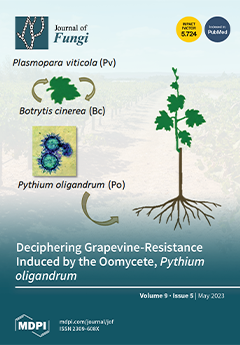Fungal allergy is the third most frequent cause of respiratory pathologies and the most related to a poor prognosis of asthma. The genera
Alternaria and
Cladosporium are the most frequently associated with allergic respiratory diseases, with
Alternaria being the one with the highest
[...] Read more.
Fungal allergy is the third most frequent cause of respiratory pathologies and the most related to a poor prognosis of asthma. The genera
Alternaria and
Cladosporium are the most frequently associated with allergic respiratory diseases, with
Alternaria being the one with the highest prevalence of sensitization.
Alternaria alternata is an outdoor fungus whose spores disseminate in warm and dry air, reaching peak levels in temperate summers.
Alternaria can also be found in damp and insufficiently ventilated houses, causing what is known as sick building syndrome. Thus, exposure to fungal allergens can occur outdoors and indoors. However, not only spores but also fungal fragments contain detectable amounts of allergens and may function as aeroallergenic sources. Allergenic extracts of
Alternaria hyphae and spores are still in use for the diagnosis and treatment of allergic diseases but are variable and insufficiently standardised, as they are often a random mixture of allergenic ingredients and casual impurities. Thus, diagnosis of fungal allergy has been difficult, and knowledge about new fungal allergens is stuck. The number of allergens described in Fungi remains almost constant while new allergens are being found in the Plantae and Animalia kingdoms. Given Alt a 1 is not the unique
Alternaria allergen eliciting allergy symptoms, component-resolved diagnosis strategies should be applied to diagnose fungal allergy. To date, twelve
A. alternata allergens are accepted in the WHO/IUIS Allergen Nomenclature Subcommittee, many of them are enzymes: Alt a 4 (disulfide isomerase), Alt a 6 (enolase), Alt a 8 (mannitol de-hydrogenase), Alt a 10 (aldehyde dehydrogenase), Alt a 13 (glutathione-S-transferase) and Alt a MnSOD (Mn superoxide dismutase), and others have structural and regulatory functions such as Alt a 5 and Alt a 12, Alt a 3, Alt a 7. The function of Alt a 1 and Alt a 9 remains unknown. Other four allergens are included in other medical databases (e.g., Allergome): Alt a NTF2, Alt a TCTP, and Alt a 70 kDa. Despite Alt a 1 being the
A. alternata major allergen, other allergens, such as enolase, Alt a 6 or MnSOD, Alt a 14 have been suggested to be included in the diagnosis panel of fungal allergy.
Full article






